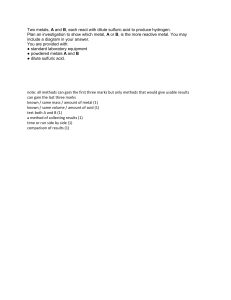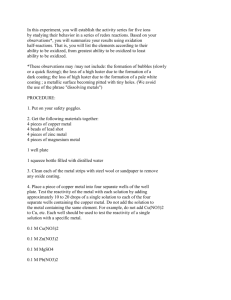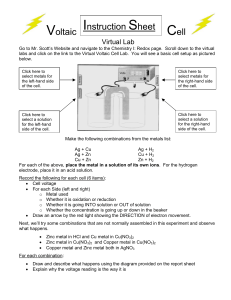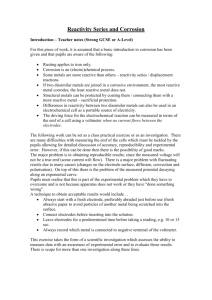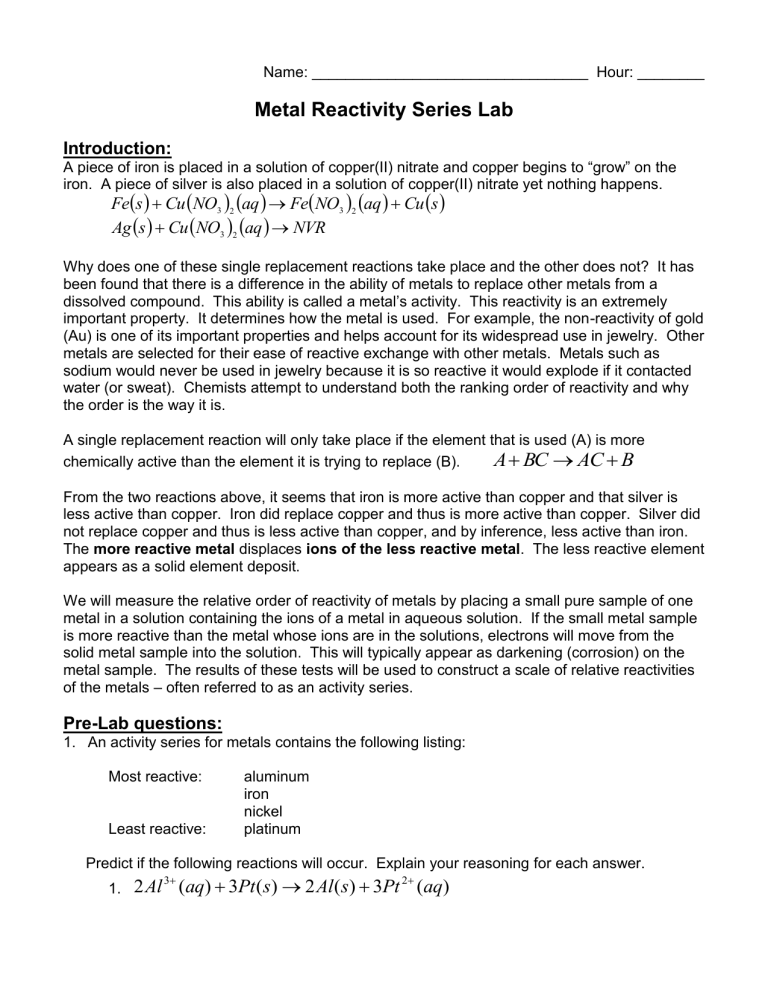
Name: _________________________________ Hour: ________ Metal Reactivity Series Lab Introduction: A piece of iron is placed in a solution of copper(II) nitrate and copper begins to “grow” on the iron. A piece of silver is also placed in a solution of copper(II) nitrate yet nothing happens. Fes Cu NO3 2 aq Fe NO3 2 aq Cu s Ag s Cu NO3 2 aq NVR Why does one of these single replacement reactions take place and the other does not? It has been found that there is a difference in the ability of metals to replace other metals from a dissolved compound. This ability is called a metal’s activity. This reactivity is an extremely important property. It determines how the metal is used. For example, the non-reactivity of gold (Au) is one of its important properties and helps account for its widespread use in jewelry. Other metals are selected for their ease of reactive exchange with other metals. Metals such as sodium would never be used in jewelry because it is so reactive it would explode if it contacted water (or sweat). Chemists attempt to understand both the ranking order of reactivity and why the order is the way it is. A single replacement reaction will only take place if the element that is used (A) is more A BC AC B chemically active than the element it is trying to replace (B). From the two reactions above, it seems that iron is more active than copper and that silver is less active than copper. Iron did replace copper and thus is more active than copper. Silver did not replace copper and thus is less active than copper, and by inference, less active than iron. The more reactive metal displaces ions of the less reactive metal. The less reactive element appears as a solid element deposit. We will measure the relative order of reactivity of metals by placing a small pure sample of one metal in a solution containing the ions of a metal in aqueous solution. If the small metal sample is more reactive than the metal whose ions are in the solutions, electrons will move from the solid metal sample into the solution. This will typically appear as darkening (corrosion) on the metal sample. The results of these tests will be used to construct a scale of relative reactivities of the metals – often referred to as an activity series. Pre-Lab questions: 1. An activity series for metals contains the following listing: Most reactive: Least reactive: aluminum iron nickel platinum Predict if the following reactions will occur. Explain your reasoning for each answer. 1. 2 Al 3 (aq) 3Pt (s) 2 Al (s) 3Pt 2 (aq) 2. Fe( s) Ni 2 (aq) Fe 2 (aq) Ni( s) 3. Pt 2 (aq) Fe(s) Pt (s) Fe 2 (aq) Procedure: 1. Obtain 2 24-well micro-reaction plates. Place on white paper to help visualize reactions. 2. Obtain metal samples of Mg (ribbon snippet), Sn (pellet), Al (foil), Zn (powder), Cu (pellet), Pb (powder), and Fe (powder). Try to pick samples which are relatively shiny. 3. Each metal sample should be placed across a horizontal row of 6 wells. Be sure your powder samples are relatively SMALL (only a few granules 15-20). Use only 2-3 SMALL pellets. 4. Obtain a micro-scale dispenser set of solutions in labeled pipets. These should contain the following solutions: Pb NO3 2 AgNO3 CuSO 4 MgSO 4 Fe NO3 2 ZnCl 2 5. Dispense 1-2 drops of the solutions into each different metal sample (move down vertically). 6. Observer the reaction for 3-4 minutes. Examine the original metal material for any evidence of a replacement reaction as coating of new metal forms on the surface of the solid metal in the well. 7. Record replacement as a positive reaction and NVR (no visible rxn) as a negative. 8. After recording data, tap all reaction wells on paper toweling and rinse and dry reaction wells. All waste is wrapped in paper toweling and deposited in the solid waste trash. Data: Pb NO3 2 AgNO3 CuSO 4 MgSO 4 Fe NO3 2 ZnCl 2 X Magnesium Tin(II) Aluminum X Zinc X Copper(II) Lead(II) Iron(II) X X Analysis: 1. Write a net ionic chemical equation for every reaction that occurred. If a reaction did NOT occur, write NVR for the product side. 2. Using YOUR experimental data, create a ranking order of decreasing reactivity (___>___>___>___…) (hint: there are 8 metals to consider). You cannot fudge your data and simply look this up on a reactivity chart. This is CHEATING. Create your list, write the actual listing, and THEN compare to find discrepancies. Explain any discrepancies. 3. Which metal reacted with the greatest number of solutions? 4. Which metal reacted with the least number of solutions? 5. Based on this lab, why do you suppose the Statue of Liberty was made from copper instead of magnesium or zinc? 6. Based on these observations and your responses in question #2, which of the metals is most likely to be found in its “free” or uncombined state in nature? 7. Which classification of reactions would account for the reactions observed?
